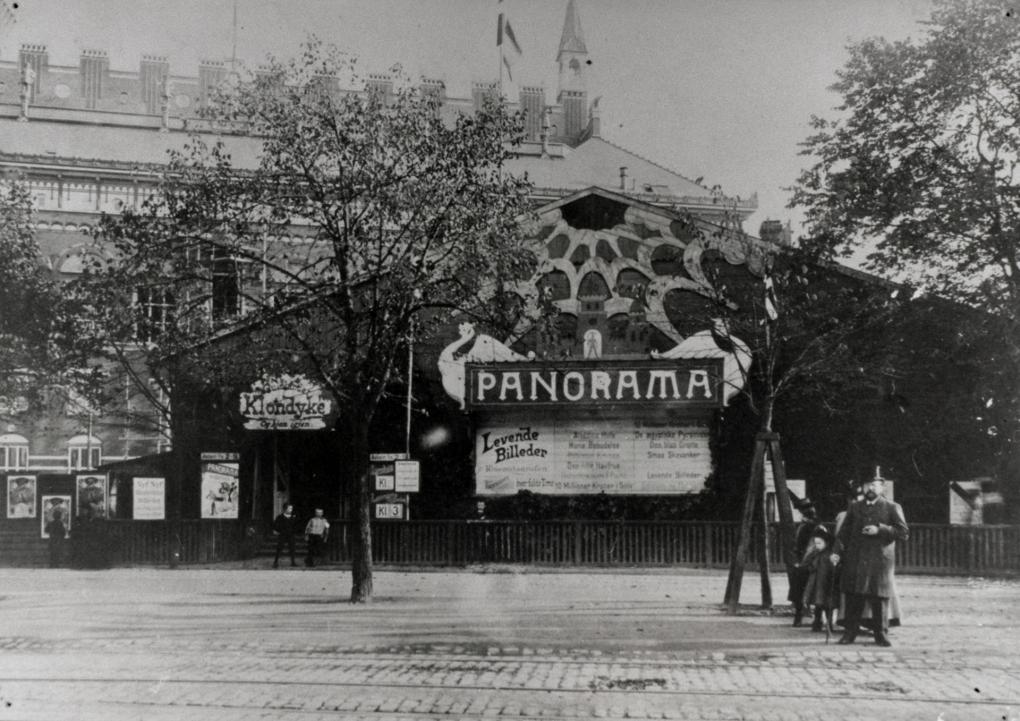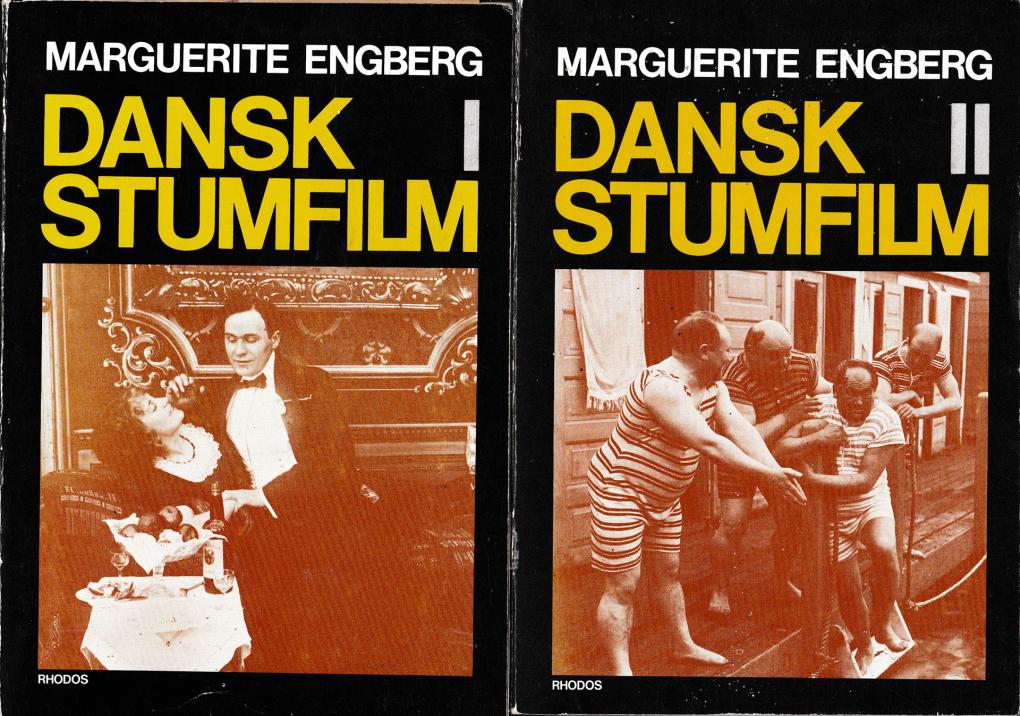
“On 7 June 1896, a little more than six months after the first film première in the world took place in Paris, the new art form arrived in this country.” So begins the article “De første danske filmforevisninger” [“The First Danish Film Shows”] by Marguerite Engberg (1919-2021), published in this journal in 1958 (Engberg 1958: 136). In a wooden pavilion on City Hall Square [Rådhuspladsen] in Copenhagen, constructed for the Independent Art Exhibition [Den frie Udstilling], the stage painter and paint manufacturer Vilhelm Pacht (1843-1912) had set up something he called the Copenhagen Panorama [Københavns Panorama], and the first attraction he presented there was “living photographs” – film.
Marguerite Engberg’s 1958 article “The First Danish Film Shows” in Kosmorama no. 33.
Beginning with the 7 June 1896 film show, Engberg surveys the film shows held in Denmark up to the establishment of the first permanent cinemas in 1904-1905 in just four fact-packed pages. Kosmorama was not a scholarly journal then, but a periodical along the lines of Sight & Sound and Bianco & Nero, directed at the general reader with a serious interest in film. Still, while Engberg’s article lacked a full scholarly apparatus, it took a more research-based approach than earlier accounts of the beginnings of cinema in Denmark; the dates of events that had formerly been left vague were now precisely established. What’s more, Engberg had to do the work in her spare time; she worked as a schoolteacher (of English and French) and became a full-time film historian only in 1967, when she was appointed to the first film studies position at a Danish university (Schepelern 2003).
In this article, I will return to the ground covered in Engberg’s pioneering article. A great deal of historical research has been done since then on the earliest years of the cinema, and film historians have many resources available today that did not exist fifty years ago. I was prompted to take an interest in the show at Københavns Panorama by one of the reviews published on the day it opened (there had been a press screening the day before), a review that described a spectator reaction quite different from those historians have described as characteristic of the so-called cinema of attractions, the mode of presentation that predominated in the earliest years of cinema. I have written an article discussing the implications of this review, written for the newspaper Politiken by Valdemar Koppel (1867-1949); the full review is included in English translation (Tybjerg 2022). Working on this article, however, I realized that there were a number of important aspects of this June 1896 film show on which both Engberg and later historians were silent. Details were lacking, for instance, about exactly what films were shown by Pacht; and investigating this, I realized that there was also something new to be said about the source of his films and his projector.
In English, the most detailed account of the Københavns Panorama film show has been written by Deac Rossell. Rossell uses the historiography of Pacht’s presentation as a cautionary example of the way errors have frequently been repeated by film historians, and his article, titled “Quartet,” is structured around four pieces of historiographical advice:
1. Everything written before 1980 is suspect: and much that was written thereafter
2. Go and look for yourself
3. Surviving objects still have much to say, even if we already think we know what they are
4. Useful information can come from anywhere, keep your eyes wide open
(Rossell 2016: 404, 408, 410, 414)
Rossell’s advice is sound. I will return to it repeatedly in the course of this article, though most of what I have to say relates to the first two points of Rossell’s quartet; I will touch on the third point only in passing, and the fourth briefly in my conclusion.
Rossell’s discussion of Pacht’s film show scrutinizes the historiography of the event rather than the event itself. I, too, will begin with an examination of the literature. In the first section, I will go over Rossell’s cautionary example and show that the error he focuses on (the claim that Pacht showed Lumière films) was in fact also present in the Danish historiography he champions. In the second section, I will look at the evidence from the Copenhagen newspapers, arguing that we can identify most of the films shown that way. I shall argue that the source of Pacht’s projection apparatus likely was not the English film pioneer Birt Acres (1857-1918), as most existing accounts state, but Robert W. Paul (1869-1943), Acres’ onetime collaborator and later rival: Pacht’s program included films that Paul made in the spring of 1896, after his break with Acres, and I therefore think it is most likely that Paul, not Acres, provided Pacht with his apparatus. In the third section, I turn back to the claim that Pacht showed Lumière films; while he did not do so in his first film show in June 1896, he may have done so when he replaced the program in December 1896. Finally, in the fourth section, I will try to look a bit more closely at the way mistakes are passed on, hopefully allowing us to avoid some of the same traps. Finally, in the conclusion, I return to Rossell’s quartet with some thoughts about the way our work as film historians is entangled with the work of those who came before us.
How do mistakes persist?
Most older film histories were written by cinephile enthusiasts, either hobbyists who did their research and writing during off hours, or professional writers whose livelihoods depended on their ability to deliver finished copy efficiently and expeditiously. Writers in such circumstances were significantly constrained in the amount of time they could devote to research and thus somewhat disincentivized from being excessively fussy about their research. In the older literature, there is an evident stress on the importance of not frittering away precious resources by going over ground that has already been covered. With much of the history of cinema remaining undocumented and unexplored, why waste time on already established facts? Furthermore, they had to publish for a general audience, with publishers who typically believed that providing books with full scholarly documentation was both an unnecessary expense and a turn-off for readers. For these reasons, many older film histories are frustratingly lacking in documentation and are often filled with unacknowledged borrowings from other books, allowing mistakes to propagate and persist.
Deac Rossell’s example of a persistent mistake is the notion that the films Pacht showed were Lumière films, and that his apparatus was a Lumière Cinématographe. Rossell lists several histories of early cinema, mainly French, some quite recent, that make this claim. He contrasts this with the work of Danish film historians who identified the source of Pacht’s projector and films as the British film pioneer Birt Acres. In her two-volume magnum opus Dansk stumfilm – de store år, Marguerite Engberg writes:“The most recent investigations show that Pacht purchased a projector from Birt Acres and returned home with that” (Engberg 1977: 13). In a footnote, she credits these investigations to Arne Krogh (1909-1985), a former actor, WW2 resistance fighter, and civil servant, who worked as a curator at the Danish Film Museum from 1948 to 1976 (www.danskefilm.dk, s.v. “Arne Krogh”). Rossell shames the French for not paying attention to this work: “That the findings of two major figures from the Danish Film Archive (Krogh and Engberg) were ignored so easily is not a good recommendation for the quality of research undertaken by historians of some standing in a major European country, and a country, indeed, with a superiority complex about its place in the origins of the cinema” (Rossell 2016: 407). The genealogy of error is a bit more complex, however.

Rossell traces the erroneous French historiography back to La grande aventure de cinéma suedois (1960), a book by Jean Béranger (1924–2000), who wrote extensively about Ingmar Bergman in Cahiers du cinéma and elsewhere (he also directed four short films, including Mic-mac (1949) with Marcel Marceau). Rossell faults later French film historians for relying on this book (Rossell 2016: 405-6). Béranger frames the arrival of the cinema in Scandinavia as a “race” between the Lumières, the inventors of the Cinématographe, and the German Skladanowsky brothers, the inventors of the Bioscop:
The same week the “Bioscop” was presented to the Norwegians, the Danish painter Vilhelm Pacht travelled to Paris, asked for an interview with Louis Lumière, and purchased one of his apparatuses from him. Two months later – more precisely, on 7 June – he opened a small wooden pavilion on City Hall Square in Copenhagen and set up the presentation of the French invention there. On 10 June, Skladanowsky arrived in the Danish capital to save the day and exhibited his device at the Tivoli gardens. The next day, the King of Denmark was present at one of Pacht’s shows, and through his august presence brought him an endorsement that the able showman used to attract a throng of the curious to his shack, to the great detriment of his rival. On 18 June, a fire erupted at Pacht’s “stand” and ravaged his projector. A briskly conducted inquiry revealed that the conflagration had been deliberately caused, by a recently dismissed electrician. Nevertheless, by 30 June, the damage had already been repaired, and the hall reopened its doors with a new projector sent from Paris in all haste. (Béranger 1960: 19-20)
Béranger has no footnotes and no works on the Danish cinema in his bibliography. Rossell assumes that he relied on Filmen (1939-41) a three-volume reference work by the Danish film historian Ove Brusendorff (1909-86), whom he inexplicably identifies as Swedish (Rossell 2016: 405-6). Brusendorff, who became the first head of the Danish Film Museum when it was set up in 1941, does indeed write that Pacht “had purchased both projector and film strips from Lumière” (Brusendorff [1939-41]: vol. 3, 112). Yet Brusendorff does not give any exact dates, whereas Béranger gives the dates of the opening, the royal family’s visit to the Panorama, the fire, and the reopening.
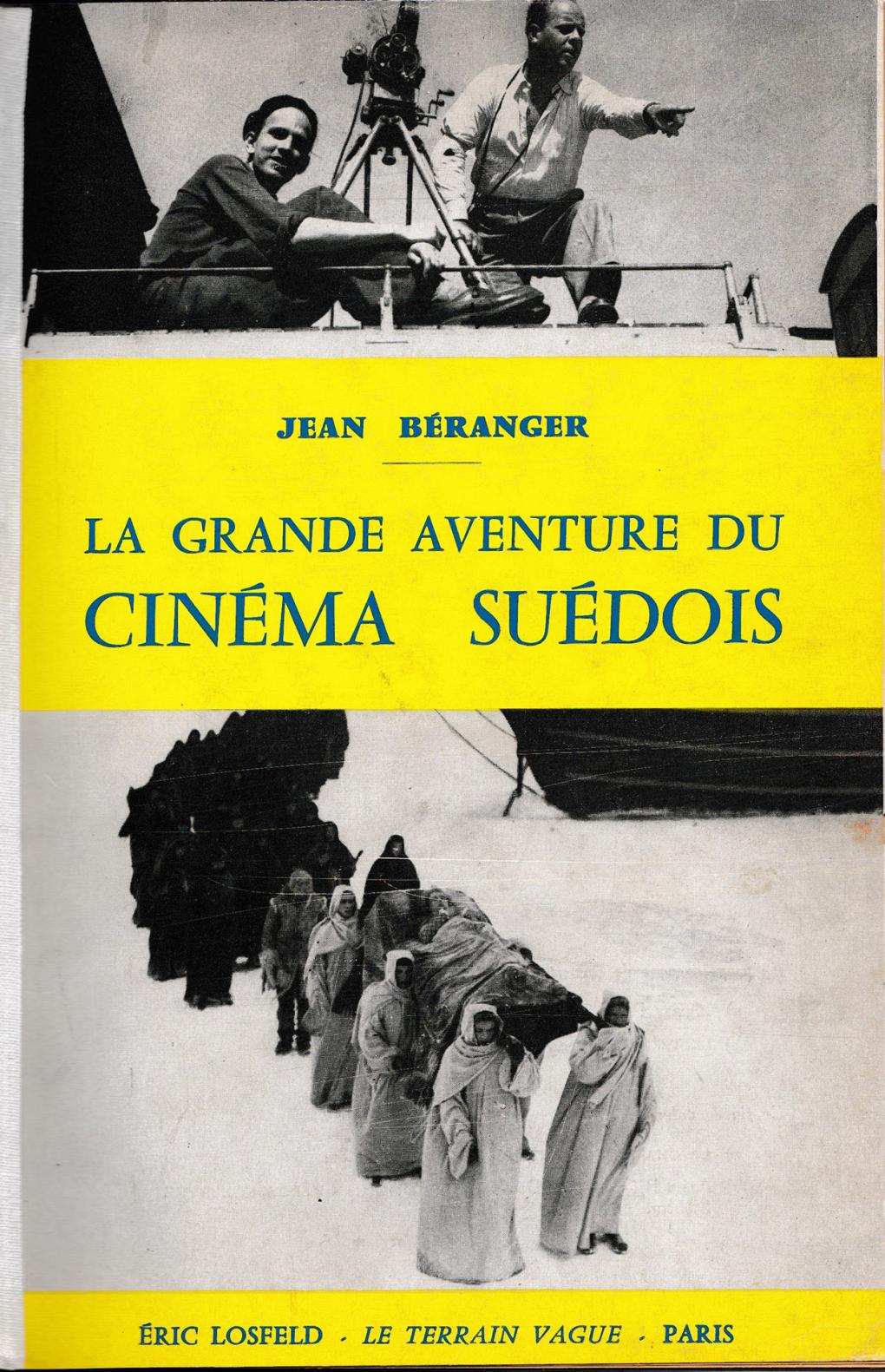
Béranger could not have found this information in any other Danish accounts either. The earliest relevant work is Filmen i social og økonomisk Belysning from 1924, a pioneering research report on the cinema as a social and economic phenomenon written by H.(ans Peter Henrik) Andersen (1872-1943), an educator and early advocate of the use of films in the classroom. The only other pre-1958 account to discuss Pacht’s show in any detail is a small 1945 book on the earliest years of the Danish cinema called Da Isbjørnen var lille (“When the Polar Bear was young”) by Arnold Hending (1901-64), a prolific writer and poet who published a number of books on Danish silent cinema, floridly written in a tone of bemused nostalgia. Andersen writes that “[Pacht] was supplied with apparatuses and films by the brothers Lumière” (Andersen 1924: 12); Hending’s account makes the same claim more elaborately. Neither Andersen nor Hending include the dates found in Béranger’s book, nor does he refer to them any more than to Brusendorff.
Instead, I am convinced that the main source for Béranger’s account of Pacht’s film show was a 1955 publication that does appear in his bibliography: Levande bilder. De första biograferna [Moving pictures: The first cinemas] by Rune Waldekranz (1911-2003). Waldekranz was a film producer and critic who in 1970 became the first full professor of film studies in Sweden, and whose historical work continues to be held in high regard. Levande bilder was a richly illustrated, large-format pamphlet published to celebrate the 40th anniversary of the Swedish cinema-owners’ association, focused on the first cinemas in Sweden, but with generous helpings of wider film history thrown in. Waldekranz’s precisely written account includes all the dates that Béranger has, but also includes the source of the information:
Arne Krogh, curator at the Danish Film Museum, reports that moving pictures were first shown in Copenhagen by the ‘painter’ Vilhelm Pacht in the wooden pavilion of the Independent Art Exhibition on 7 June 1896. The newspaper Politiken devoted a full column to the event and praised the cinematographic images highly. But they attracted even greater attention when the projector and part of the building were destroyed by fire on 18 June. The fire had been set by an electrician who had been discharged and therefore wanted revenge. Already on 30 June Pacht was able to reopen with a new and better projector. Pacht called the imported cine-apparatuses kinoptikon. But even without the fire, Pacht would have had plenty of publicity surrounding his film shows. As early as 11 June, the royal family visited
Pacht’s moving picture show and Politiken provided an extensive report on the distinguished visit.
Almost simultaneously with Pacht and his Kinoptikon the brothers Skladanowsky presented their living photographs at the pantomime theater in Tivoli. The opening was 10 June. Skladanowsky’s Bioscop remained at Tivoli for around a month. (Waldekranz 1955: 13)
Waldekranz thus makes clear that the newspaper Politiken is the source of the dates, and that he has not conducted the research into the Danish papers himself, but received the material from Krogh. It should also be evident that except for the Lumière vs. Skladanowsky horserace framing and the flashier style, Béranger’s account follows Waldekranz’s very closely.
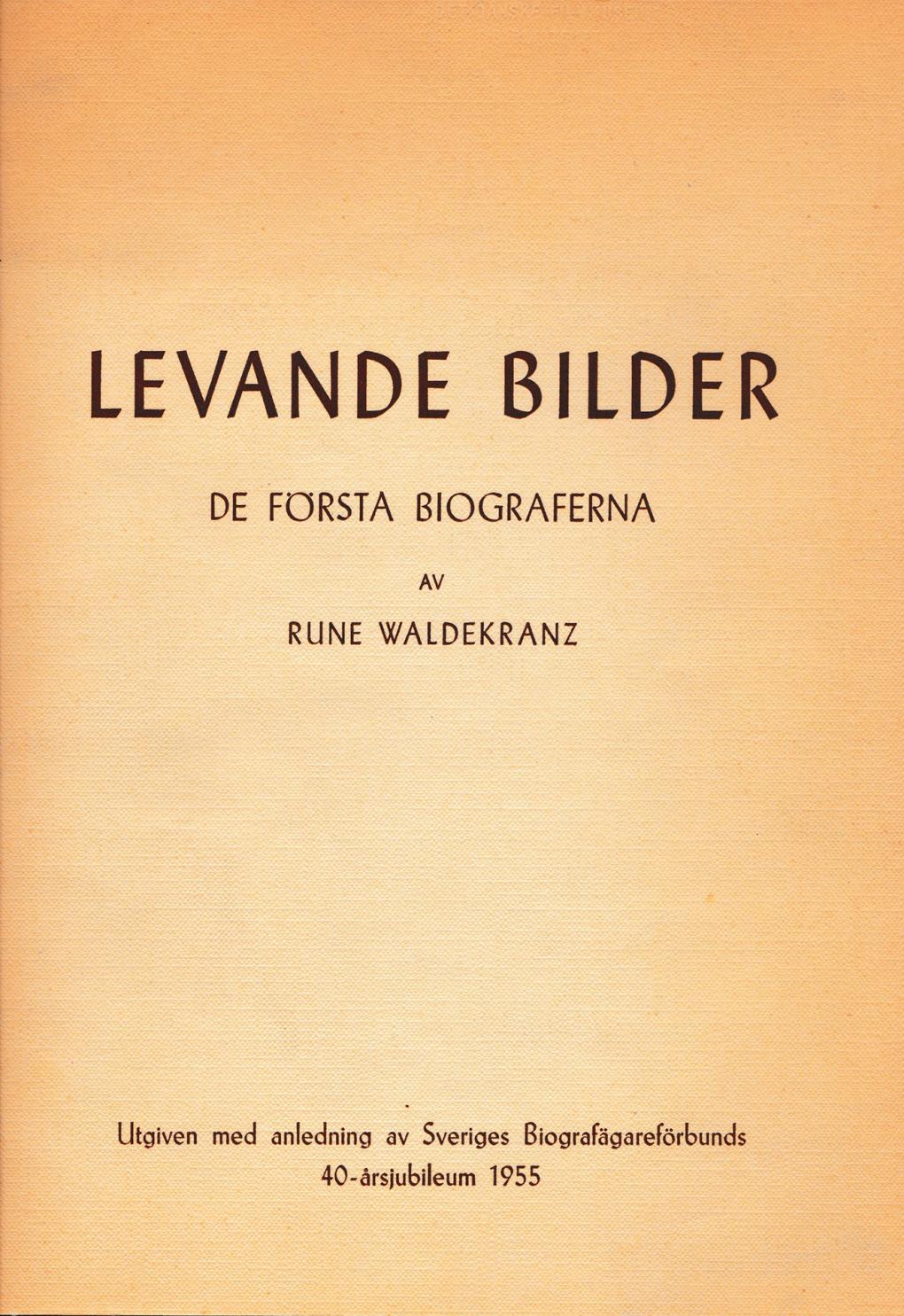
Moreover, Waldekranz unambiguously states: “Pacht showed Lumière views at ‘Panorama,’ a small venue at City Hall Square” (Waldekranz 1955: 12). Since Waldekranz relied on Krogh, and Béranger relied on Waldekranz, it would appear that the flaws in the French historiography relying on Béranger can be traced back to the very source that it supposedly ignores. (It should be said that Waldekranz draws additional information from Hending, who writes elaborately about Pacht’s visit to the Grand Café in Paris; but nothing that Krogh told him seems to have made him question the Lumière attribution). Engberg, too, seems to have believed for a long while that Pacht showed Lumière views.
In her 1958 article, she does not make any outright claims, but implies a Lumière connection through the progression of her sentences:
In the spring of 1896 he travelled to Paris to find novelties for his establishment, and here he visited the cinema at the “Grand Café,” where the cinematograph, the invention of the brothers Lumière, had enjoyed great success for several months. Pacht was enthusiastic and got hold of a projection apparatus and some films. (Engberg 1958: 136)
This passage was quoted in a polemical comment the amateur film historian John Ernst (1915-85) published in Kosmorama in 1966, noting that it leaves the question of where Pacht got his projector unanswered. Ernst expresses his surprise that he and others had been able – with only limited effort and investigative skill – to uncover “a good deal of unknown material” about early Danish film history, as well as bringing up a number of new questions; and complains that their ability to make such discoveries was “symptomatic of the depressingly low state of Danish film history writing” (Ernst & Lund 1966: 158). Ernst specifically exempted Engberg from this critique, but she nevertheless replied to Ernst in the next issue.
Pacht’s machine, Engberg claimed, worked both as a camera and a projector – like the Cinématographe. She went on to point out, citing Géorges Sadoul, that the Lumière brothers did not sell their Cinématographe at the time. Instead, the Lumières entered into profit-sharing agreements with local entertainment venues where they would send a cameraman/projectionist who kept control of the machine and the films: “Since it is known with certainty that Pacht showed Lumière films at ‘Panorama’ in the summer of 1896, I believe one can assume that he had gotten his apparatus from the Lumière brothers” (Engberg & Ernst 1966: 208; citing Sadoul 1948: 308). However, Engberg offers no documentation beyond the reference to Sadoul for her claim that “it is known with certainty” that Pacht showed Lumière films, and as we already saw, by 1977 Engberg had come round to the view that the projector came from Birt Acres.
Before we delve deeper into the historiography of the earliest Danish film shows, which I think will give us a better understanding of why the Lumière attribution was able to persist, we should examine the evidence that it was made in error; we need to follow Rossell’s advice to go and look for ourselves.
What do we find when we look for ourselves?
Pacht’s show received extensive press coverage. The wholesale digitization of older Danish newspapers has made examining it a less labor-intensive proposition than it was in the days of clippings files and microfilm. Pacht began promoting his Kinoptikon in early May 1896. On 8 May, the Copenhagen daily Politiken carried an announcement:
New Panorama in Copenhagen. The Painter Vilh. Pacht has obtained a license to etablish a permanent panorama here in town. Mr. Pacht will start the enterprise at the end of this month by exhibiting, on the premises of the Independent Art Exhibition, the latest invention in the field of optics, the so-called Kinoptikon, that produces moving, life-size pictures.
Mr. Pacht has recently returned from a trip to the great cities of Europe, where the exhibition of the new invention attracts the greatest attention, and has acquired the best of the existing apparatuses. (Politiken, 8 May 1896, italics in original)
This annoucement was reproduced in Levende billeder i Danmark, a coffee-table book on Danish film history published in 1971 by Erik Nørgaard (1929-2013), a journalist and prolific historian of popular culture (Nørgaard 1971: 20). Rossell reprints it but misdates it to June 1896 (Nørgaard only gives the year).
It is worth noting that this announcement must have been based on a press release by Pacht. On the same day, 8 May, two other newspapers, Dannebrog and Dagens Nyheder, carried announcements that were almost word-for-word identical to the first of the two paragaraphs, and a third, København, one that is evidently a rewrite of the same text (a fifth paper, Dagbladet, carried the exact same announcement as Dagens Nyheder, but the two were co-owned and regularly shared editorial content). The four texts are so similar that they must all derive from the same model, almost certainly a press release written by Pacht. We can therefore assume that by the beginning of May 1896, Pacht had returned from his European trip, either with a film projector in hand or expecting the imminent delivery of one.
The show itself opened to the public on Sunday, 7 June 1896, but the day before, Pacht had held a press screening and offered the journalists champagne (Politiken, 7 June 1896). Pacht’s courting of the press bore fruit: eight Copenhagen dailies carried reviews on the day of the opening: Aftenbladet, Dannebrog, København, Politiken, Social-Demokraten, Dagbladet, Dagens Nyheder, and Nationaltidende (the last three, known as the Ferslew papers, were co-owned and published identical reviews). Two more dailies, Adresseavisen and Berlingske Tidende, did not have Sunday editions and carried reviews on 8 June. Frederiksborg Amts Avis, a major provincial newspaper, had a detailed review on 9 June. The same review appears in a number of other provincial papers that were part of the Berg paper corporation (De Bergske Blade), including Morsø Folkeblad, Stubbekøbing Avis, Svendborg Avis, and Viborg Stifts Folkeblad.
Pacht called the film show “Kinoptikon” and referred to the films as “levende Billeder,” which literally means “living pictures,” but is more idiomatically rendered as “moving pictures” – the term “levende billeder” remains in use, and is used in much the same way as “moving pictures” in English. Both terms appear on the poster, which appears to have been drawn by Erik Henningsen and ready for the opening (“The painter Erik Henningsen has drawn an advertising poster that will attract well-deserved attention,” Social-Demokraten, 7 June 1896).
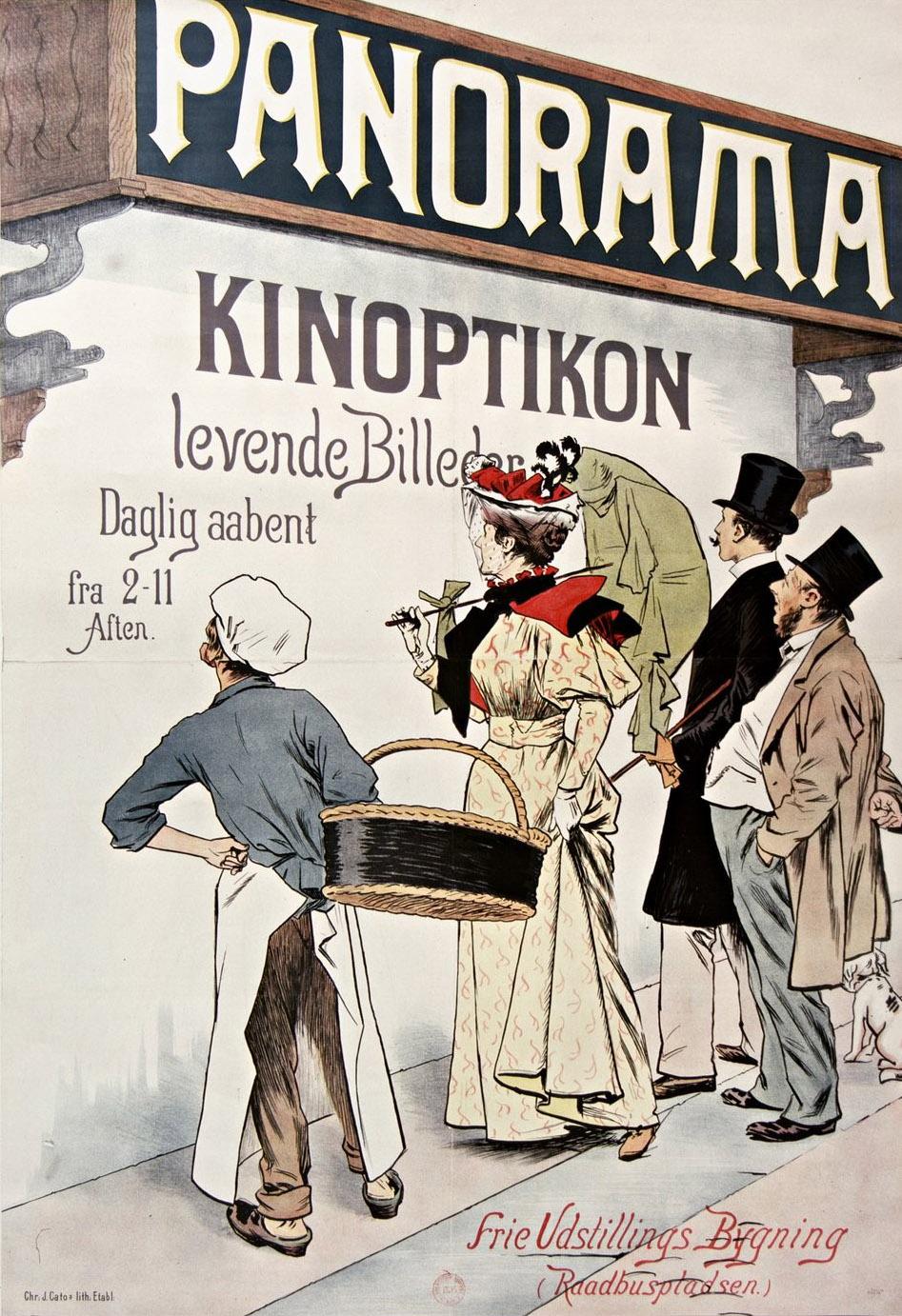
The word “Kinoptikon” is very similar to the name Birt Acres chose for his apparatus, “Kineoptikon.” For a Danish-speaker, “Kinoptikon” rolls more easily off the tongue, and it evokes “Panoptikon,” which was the name of the Copenhagen waxworks display that was situated down the street, only 300 meters away; so it could very well be simply a change of spelling to aid pronounciation. The similarity to Acres’ term is the strongest piece of evidence that Pacht had obtained his projector from Acres. There are no documents that I have been able to find that give any specifics about where Pacht got his projector, although one review does note that it came from England: “It is the well-known painter Vilh. Pacht who after various travels to London has succeeded in introducing the strange invention to the Danish audience.” (Frederiksborg Amts Avis, 9 June 1896). Furthermore, all the reviews except for those in Politiken and Berlingske Tidende describe at least some of the films as showing English scenes.
Aftenbladet mentions a film showing “life on the streets of London,” and Social-Demokraten describes the show as consisting of “foreign, particularly Londonian, views.” Dannebrog describes “the English speed and vigor” of passengers rushing out of the arriving train, continuing: “More generally, one senses from most of the views that their subjects have been taken from a country, where it more than anywhere else holds true that time is money! [English in original]” (Dannebrog, 7 June 1896). The English location of another film showing crashing waves is specifed in several newspaper reports from later in the month: “the breakers at Dover with the rolling waves smashed into spray against the sandbars of the shore” (Politiken, 30 June 1896); “Among the many pictures, the waves at the coast of Dover are as usual the biggest hit” (København, 30 June 1896).
The additional press coverage on 30 June was occasioned by the re-opening of the Kinoptikon; it had been forced to close on 18 June because of a fire (of which more later). On 1 July, the newspaper København carried a front-page ad including a list: “Kinoptikon currently contains the following pictures,” indicating that this was the complete program:
From an English racetrack
Surf at Dover
Sunday at Kempton Park
Street scene in London
Railway train (arrival)
Blackfriars Bridge, London
A blacksmith’s workshop
Serpentine dance
A magician
An article in the same paper the previous day stated that the program after the reopening included two new films: “One shows a particularly beautiful serpentine dancer, and the other a very amusing magician, who to a not inconsiderable degree resembles Georg Brandes. He does different things and amongst others pulls from his hat a rabbit, which later turns into two, and a long series of ribbons” (København, 30 June 1896). Since the last two films on the list were identified as “new,” the rest had presumably been part of the initial program.
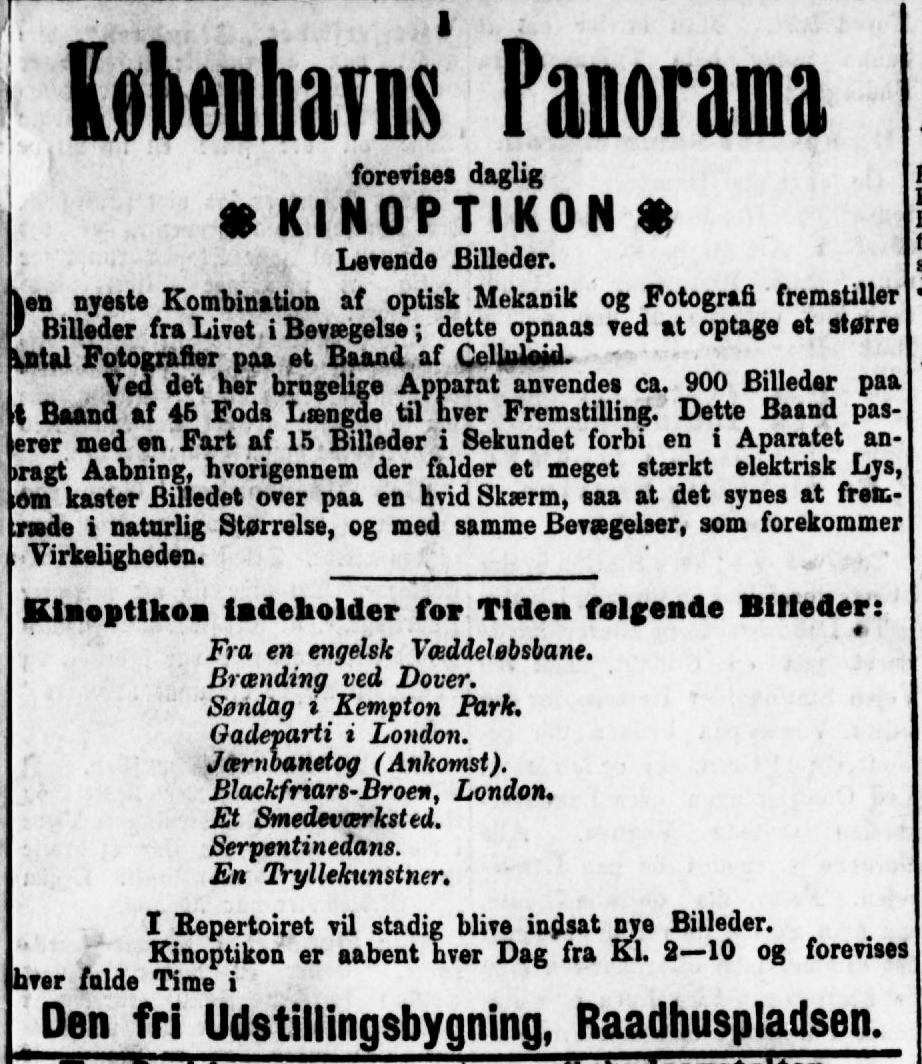
“Surf at Dover” is almost certainly Robert Paul and Birt Acres’ Rough Sea at Dover (1895), listed in John Barnes’ filmography of the earliest British films as Paul-Acres no. 13. Working from this filmography, some films on the list also appear to be among those made by Robert Paul and Birt Acres together in 1895, but not all of them (Barnes 1998: 229-66). The first of the two racetrack scenes is probably the 1895 The Derby (Paul-Acres no. 5, 1895); the 1896 Derby was run on 3 June, and it seems unlikely that a print of either Paul’s or Acres’s films of it could have reached Copenhagen in three days. Kempton Park is also a racetrack, but no films appear in the Barnes filmography that specifically refer to it. The street scene may be London Street Scene (Paul-Acres no. 12, 1895).
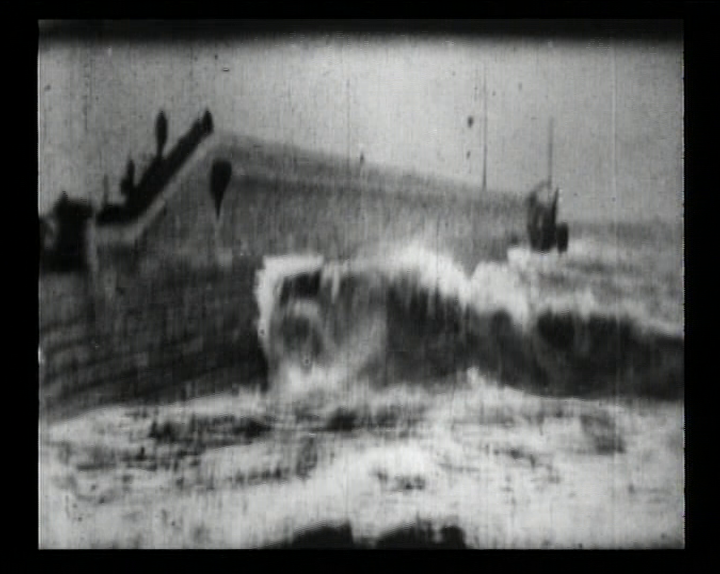
Paul and Acres were collaborators in early 1895, but went their separate ways in July of that year (Brown & Anthony 2017: 147). Paul made films independently from Acres in 1896 after the two parted ways, and some of these Paul-only films were very likely among those shown by Pacht. This includes the intriguing “Railway Train (arrival).” One newspaper specifies that the train arrives at Calais (Aftenbladet, 7 June 1896), which fits with Arrival of the Paris Express “at Calais (Maritime) and passengers disembarking” (Paul no. 2, 1896; Barnes 1998: 247). The magician pulling rabbits out of a hat is almost certainly David Devant: The Mysterious Rabbit (Paul no. 20, 1896), and the film of Blackfriars Bridge is probably Blackfriars Bridge (Paul no. 29, 1896).
However, there does not appear to be any British films predating mid-1896 of either blacksmiths or serpentine dancers. Most likely, these were the Edison Kinetoscope films Annabelle Serpentine Dance (no. 49 in Charles Musser’s Edison filmography) and Blacksmithing Scene (no. 16; Musser 1997: 111, 83). Pacht could have bought them in London, but prints had also made their way to Copenhagen. In fact, the very same building that would house Pacht’s Panorama had previously been used as a showcase for Edison phonographs. The phonographs were exhibited from 15 July 1894; patrons could listen to a series of recordings through individual eartubes (Politiken, 13 July, 1 September 1894). On 26 December 1894, the establishment added four Kinetoscopes, showing a serpentine dancer, a pair of boxing cats, a barroom scene, and a female floor gymnast (Politiken, 26 December 1894); another paper describes the last as a “lady contortionist” (Adresseavisen, 24 December 1894). Referring to Musser’s filmography, we can tentatively identify the films as Annabelle Serpentine Dance (no. 49), The Boxing Cats (Prof. Welton’s) (no. 41), A Bar Room Scene (no. 37), and Bertoldi (Table Contortion) (no. 30) (Musser 1997: 111, 104, 99, 96). In late February, new films were presented: blacksmiths, three “dancing negroes,” and “Texas Jack” (Politiken, 28 February 1895). The first one is almost certainly Blacksmithing Scene (no. 16); the second most likely The Pickaninny Dance – From the “Passing Show” (no. 71); and based on the following description, the third is probably Bucking Bronco (no. 79) (Musser 1997: 83, 133, 140): “It shows a cowboy, who rides his spirited Texan horse around an open ring and lets the animal jump over a barrier from time to time, while a score or so of spectators observe with interest, occasionally applauding” (Kjøge Avis, 1 March 1895). The kinetoscope film was probably called Texas Jack to sponge off of the success of a hit play of that title, a Danish adaptation of the American election comedy A Texas Steer (1890) by Charles H. Hoyt (1859-1900).
The number of Kinetoscopes on display, according to the newspaper report, was four. In Brown and Anthony’s The Kinetoscope: A British History, they refer to a shipping manifest in the Thomas A. Edison Papers, Digital Edition, listing four Kinetoscopes shipped to Copenhagen (Brown & Anthony 2017: 7, citing TAED D9428AAL). The recipient is listed as “P. Soht” – probably P. Søht & Co., an exporting and insurance company, acting as an agent for the operators of the phonograph parlor. Each Kinetoscope was individually numbered, and the ones sent to Copenhagen were no. 211-13 and 280. As it happens, the collections of the Danish Film Institute include a Kinetoscope (inventory no. 150): it carries the number 211 on a brass plate on its top. (However, at the Cinematek in Bruxelles, there is another Kinetoscope bearing the number 211; one of them must be a replica. I have examined the one in Copenhagen, as Rossell’s third rule recommends, but have not been able to establish conclusively whether this machine is indeed one of the four shipped to Copenhagen from New Jersey in the fall of 1894).
The Edison show closed down on 17 March 1895, when the Independent Art Exhibition took over the building, but in June, the Edison display returned (Dagens Nyheder, 19 June; Politiken, 21 June 1895). In August 1895, a Kinetophone was added; the serpentine dance was now accompanied by music (Dannebrog, 18 August; Politiken, 21 August 1895). The Edison show closed down on 22 December (Politiken, 15 December 1895). The writers of a detailed study of the “Phonograph concerts” conclude that they had gone out of business (Nielsen & Byrith 2017: 38-39). Pacht could conceivably have bought some of their films.
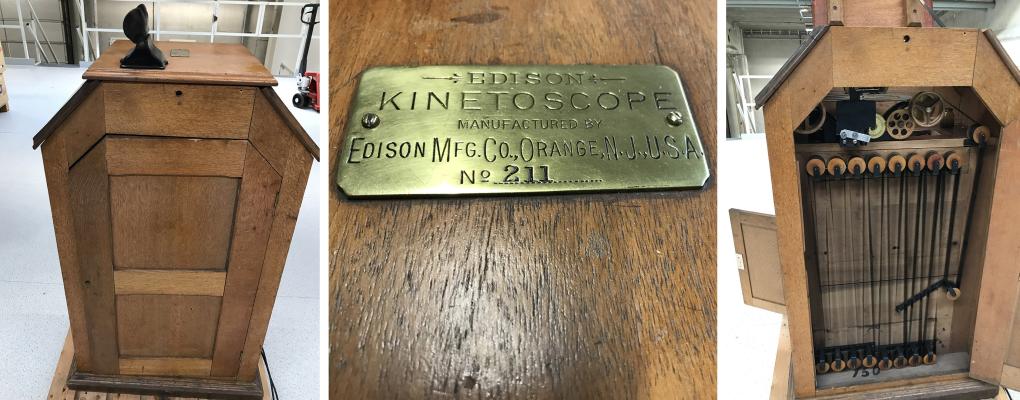
Returning to the hypothesis that Pacht bought a projector from Acres: another reason why I am skeptical of it is that it is far from clear whether Acres had any for sale at that point. Rossell notes that there were a number of pioneers active in London who were showing cinematographic pictures in the spring of 1896: “In London, Pacht could have seen apparatus from Robert Paul, Birt Acres, Rigg and Kumberg, Wrench & Sons, and possibly one or two others” (Rossell 2016: 407). However, the implication that Pacht could have acquired a projector from any of these except Paul is one that we should not necessarily accept. In his 2019 book on Robert Paul, Ian Christie states unequivocally: “Paul was in fact the only manufacturer in Europe selling workable projectors on the open market in March-April 1896” (Christie 2019: 58, emphasis in original).
Acres’s Kineopticon was presented to the public in March 1896 at Picadilly Circus, but the first indication that he had any for sale dates for late June, and the first advertisement naming Acres and his apparatus is from August. John Barnes, author of the standard history of the beginnings of the cinema in Britain, argues that the August adverstisement was “a canard” on the basis of a statement Acres made at a meeting of a photographic association in Liverpool in late October:
The Liverpool statement clearly suggests that, as of 29 October, the apparatus had not appeared on the market, and considering the general lack of information concerning it, I am of the opinion that it was never in fact commercially produced, and that no more than three machines were ever manufactured. (Barnes 1998: 76)
If Barnes’ analysis is correct – and it seems convincing to me – the Acres apparatus was (to use an ananchronistic term) vaporware. Pacht would not have been able to buy one in March or April.
What do we do with contradictory information?
A large number of contemporary press accounts, then, all support the conclusion that the films Pacht showed were mostly English; we can match most of them with known titles from the production of Robert Paul, some of them (but not all) made in collaboration with Acres. There are a few sources, however, that contradict my conclusion here.
Three weeks ahead of the opening, a newspaper reported that Pacht “the day before yesterday concluded the final contract with the inventor company of MM. the brothers Lumière of Lyon” (Dannebrog, 17 May 1896), followed by a fairly detailed description of a Lumière show the reporter had seen in Berlin. This would have been quite recent: the first presentation in the German capital of the Lumière Cinématographe took place on 28 April 1896 (Loiperdinger 1999: 135). This report is the only one out of the many items on Pacht’s film show that specifically identifies the source of his apparatus.
Still, since this press notice is contradicted by the rest of the historical record, it is most likely that the reporter made a mistake. One should certainly not assume that all 1890s press reports are reliable, but we should explain what we are doing if we decide to dismiss a part of the historical record. In this case, we can offer a possible, if speculative, explanation for the reporter’s error: he may not have been aware of the existence of several different competing motion-picture devices, and simply assumed that the one Pacht acquired was the same as the one he had experienced in Berlin.
It is unlikely that either Krogh or Engberg knew of the item in Dannebrog. There is no indication that they looked at other newspapers than Politiken. The review in that paper is very impressionistic, with few firm details but with a vivid description of the film of the train arriving – which Engberg quotes both in 1958 (136) and 1977 (13-14). There is nothing in Politiken’s account that clearly contradicts the notion that Pacht showed Lumière films, and as we have already seen, all accounts written before Engberg’s that gave any details about the content of Pacht’s show either state definitely or imply that he showed Lumière films. Engberg knew the literature well, having compiled a still-useful bibliography of Danish literature on film (Engberg 1964).
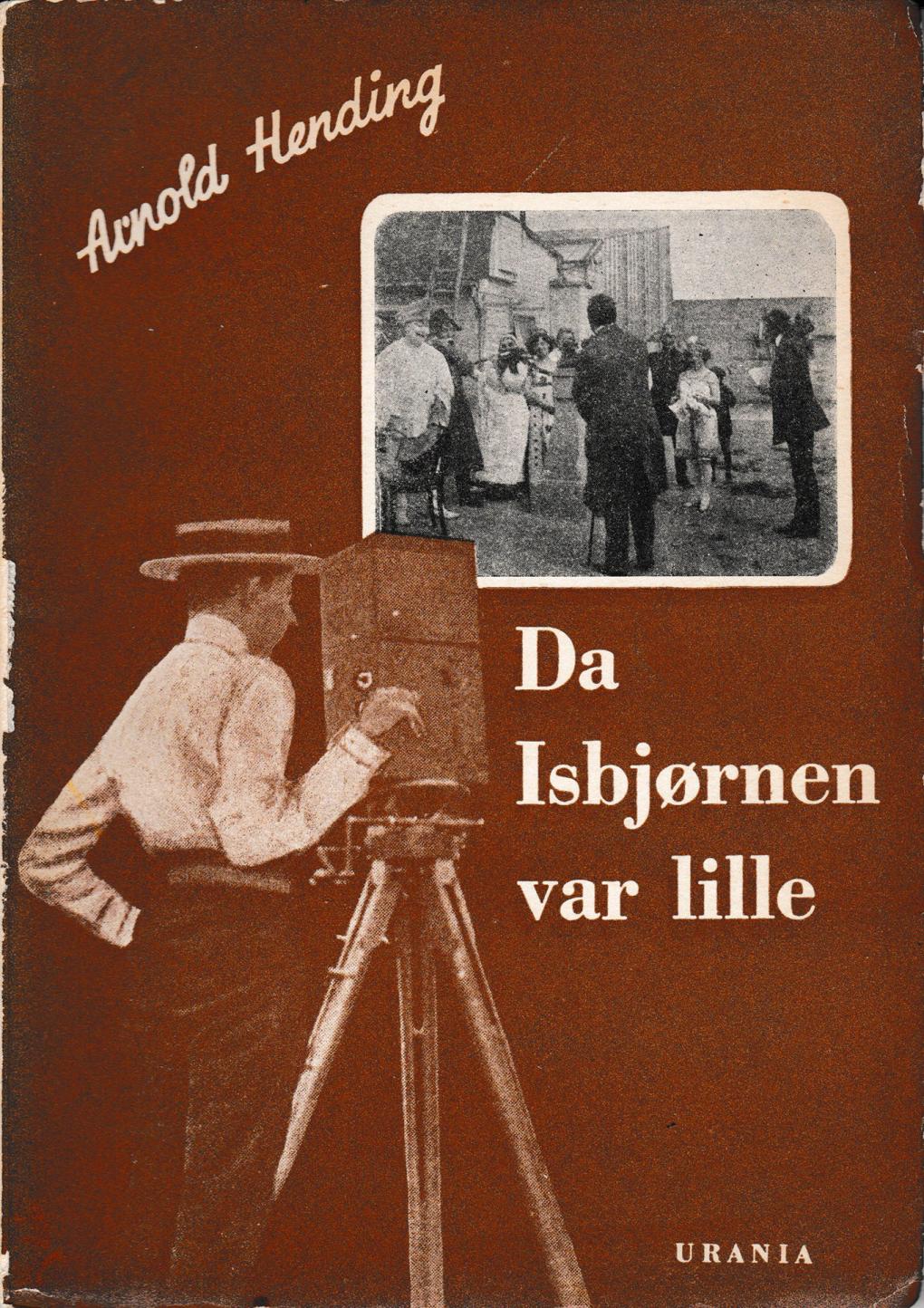
Hending’s account in Da Isbjørnen var lille is quite essayistic, but it does include an indirect reference that points towards the other piece of evidence for the claim that Pacht got his films from France. Hending describes Pacht visiting the film show at the Grand Café, which he associates with the manager, Clément Maurice (or Clément-Maurice; 1853-1933):
To Maurice’s uncomfortable yet “fateful” cine-basement came one day two well-known and ambitious Copenhagen men – the short, barrel-shaped painter and party arranger Vilhelm Pacht, who would soon develop into a Barnum on a Danish scale, together with the writer J. J. Ipsen. The latter served as an interpreter during his and Pacht’s Parisian voyage, which would have such far-reaching consequences. (Hending 1945: 11-12)
The writer J. J. Ipsen is Johannes Jacobus Ipsen (known as Jean Jacques; 1857-1936), a Danish journalist and self-described anarchist. Ipsen moved to Paris in 1889 and lived there for a decade; a good part of his autobiography is given over to his (somewhat unstructured and overgeneralizing) reminiscences of France. He briefly mentions his involvement with Pacht:
It has been said that France is always ahead when it comes to ideas and behind when it comes to action. It is also supposed to be the land of penniless inventors. There I remember seeing living pictures for the first time, or film as we now say. It was in the company of Vilhelm Pacht and likely in 1896; I was a translator for him at the Parisians’ first film theatre, located on the Boulevard Saint-Martin. The pictures flickered dreadfully; afterwards we went to the home of the manager, and Pacht bought some of the best ones, at prices that as far as I recall did not exceed 150 Francs per film. (Ipsen 1926: 132)
Although Hending does not say so, he definitely relied on Ipsen’s autobiography; without acknowledgement, he weaves Ipsen’s bon mot about France being ahead with ideas and behind with action into his own text, word for word (Hending 1945: 11).
With sufficient time and dilligence, it might have been possible to work one’s way back to the autobiography from the mention of Ipsen’s name. Fortunately, I did not need to do so. John Ernst discovered it back in the 1960s, or rather, he “had [his] attention drawn to it by others,” and quoted the passage in a brief note in Kosmorama no. 81. The full run of the journal was digitized and made searchable in August 2019, and I found the note when I did a search for “Pacht.” Ernst concludes:
Even if the passage only mentions the purchase of films (with prices) it may provide the explanation for the way Vilhelm Pacht acquired his projection apparatus, something which has hitherto remained unclear. In her article, Marguerite Engberg only writes, “Pacht got hold of a projection apparatus and some films.” The “manager” mentioned in the text can of course only be one of the Brothers Lumière. (Ernst 1967: 13; quoting Engberg 1958: 136).
Ernst jumps to conclusions here, and we should be more cautious. If we turn to Jacques and Chantal Rittaud-Hutinet’s impressively documented survey of all film shows in France in 1896-97, Dictionnaire des cinématographes en France (1896-97), we find no evidence of a cinematograph show, let alone a “film theatre” in the Boulevard Saint-Martin. However, from March 1896, the Lumière cinématograph was shown at several venues in addition to the Grand Café, one of them at the Théâtre Eldorado (now le Théâtre libre) at no. 4, Boulevard de Strasbourg, which is very close to the Boulevard Saint-Martin.
The show Ipsen remembered may indeed the Cinématographe show at the Eldorado. It began no later than 30 March 1896 (Rittaud-Hutinet & Rittaud-Hutinet 1999: 356), and the size of the room (the Eldorado was the largest music hall in Paris; http://www.ecmf.fr/cm/indexc2f3.html) could explain why the pictures flickered so badly. That does not mean that the “manager” who sold several films to Pacht was one of the Lumière brothers; they had quite a few competitors, and the “manager” could have been any one of them. While his identity will remain elusive, we can learn a great deal more about Pacht’s French connections if we examine his second film program.
Pacht apparently kept showing the films presented in June for the rest of the year. On Christmas Day 1896, they were entirely replaced with a new program. The newspaper accounts are less detailed than those for the first show, and they tend to emphasize the Panorama’s other brand-new attraction: a series of electrically illuminated peepshow tableaux showing the exploits of polar explorer Fritjof Nansen was added (his expedition had disappeared into the Artic three years earlier; it was one of the biggest news stories of 1896 when he returned alive). (Another non-film attraction had been added in September: a life-size Chinese opium and gambling den – apparently an enclosed set with performers, “seven genuine Chinese,” viewed from a sort of balcony (Politiken, 23 September 1896; Fredericia Dagblad, 28 December 1896)).
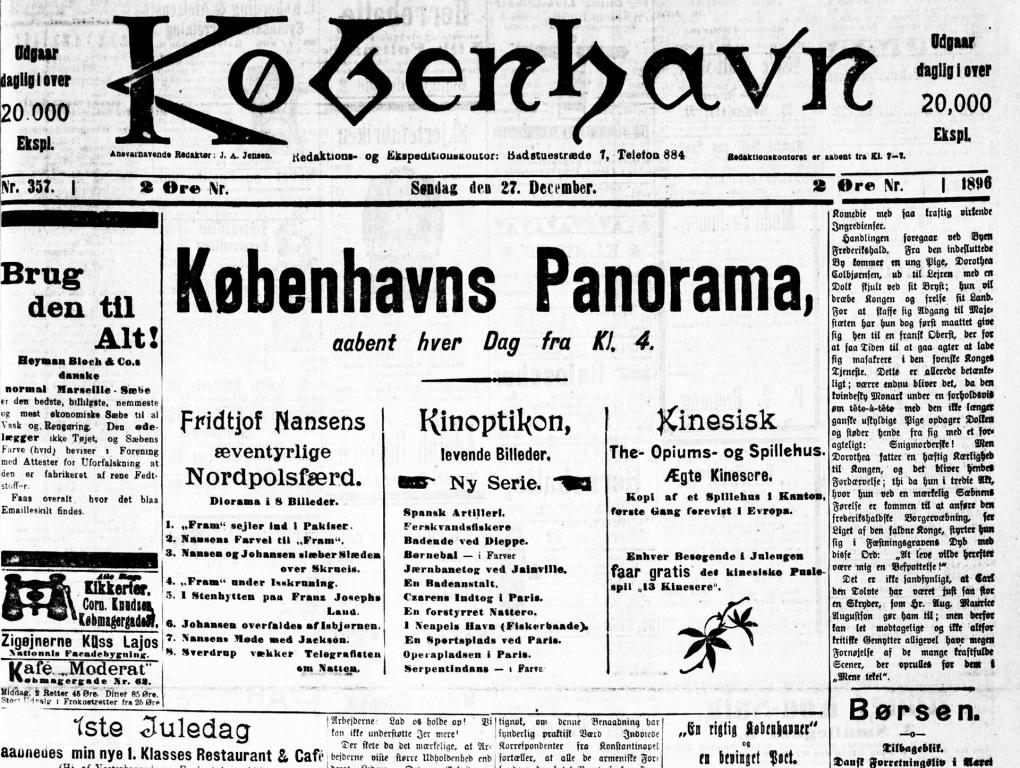
Still, we have a front-page ad in one of the papers (København, 27 December 1896) listing the titles in the new film series:
Spanish Artillery
Fresh-water Fishermen
Bathers at Dieppe
Children’s Ball – in color
Railway train at Joinville
A Bathing Establishment
The Entry of the Czar into Paris
Interrupted Sleep
The Port of Naples (Fishing Boats)
A Sporting Field at Paris
The Place de l’Opéra in Paris
Serpentine Dance – in color
Evidently, these were largely French films, and at least some of them would have been recently acquired. The newly-crowned Czar Nicholas II of Russia visited France in early October, with an official parade through Paris on 6 October 1896. At least some of these films, then, must have been acquired after that date. Perhaps Pacht went back to Paris in the fall, and Ipsen’s recollections are from that time (strictly speaking, we cannot be certain that the trip to “the great cities of Europe” Pacht mentioned in his press release in May actually took him to Paris, though it seems unlikely that he did not go there). Interestingly, the films appear to come from more than one producer.
Some are most likely to be films by Georges Méliès (1861-1938). Interrupted Sleep is described in a newspaper report: “a man is roused from his peaceful sleep by a cockroach and begins a spirited pursuit of the pest” (Dannebrog, 24 December 1896) – which sounds very much like the Méliès film Un Nuit terrible, no. 26 in the Méliès filmography(Malthête & Mannoni 2008: 89, 335). The train at Joinville could well be Méliès’ film no. 35, Arrivée d’un train (Gare de Joinville) (Malthête & Mannoni 2008: 336). Both of these Méliès films have recently been painstakingly restored from contemporary flip-books (see Lecointe, Fouché, Byrne & Hutchinson 2020) and made available for online viewing at the website of the San Fransisco Silent Film Festival.
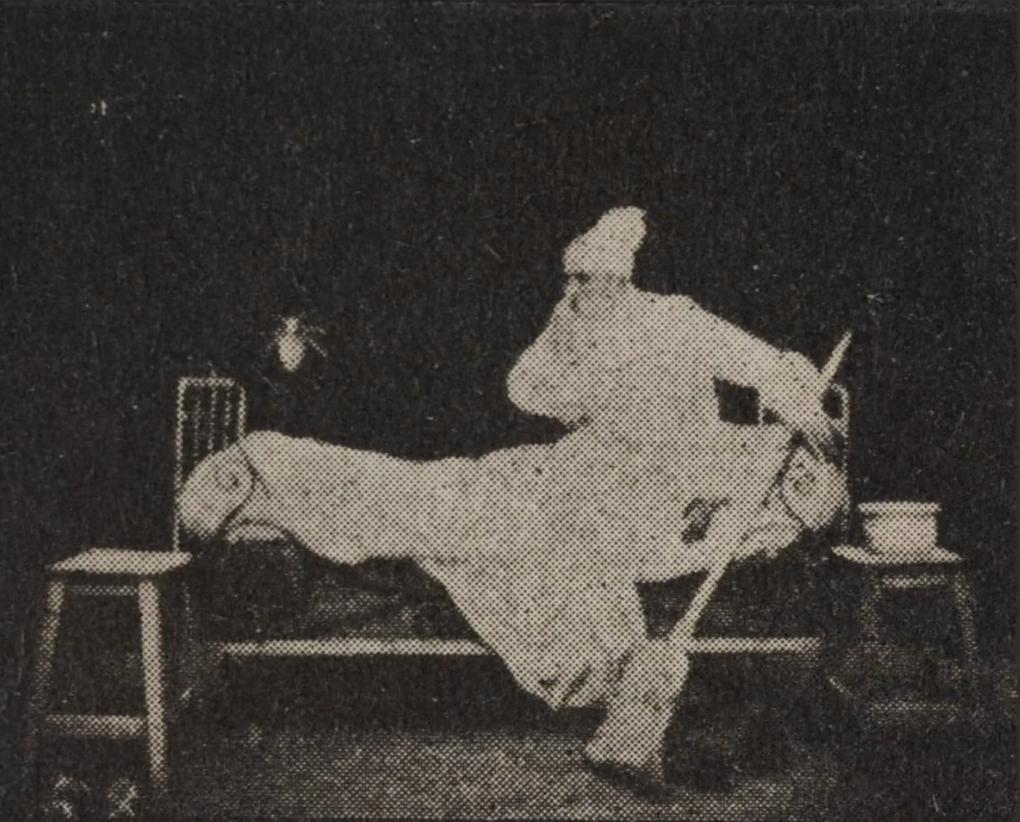
Some of the other films, however, do not match any known Méliès titles. One of these is “Bathers at Dieppe”: Méliès did shoot seaside scenes in Normandy in the summer of 1896, but at Trouville-sur-Mer. However, among the films made with the cinematograph invented by Henri Joly (1866-1945) and marketed by Ernest Normandin (1862-1934) is one identified as La Mer à Dieppe, first shown in September 1896 (Blot-Wellens 2014: 154). Both Méliès and Joly-Normandin released hand-colorored films of serpentine dancers: a hand-colored print of the Joly-Normandin Danse serpentine survives, and there is a newpaper record of a showing of Méliès’ Danse serpentine (no. 44) in Lisbon mentioning its coloring; moreover, five flip-books survive that most likely are based on this film, and all are hand-colored (Blot-Wellens 2014: 135-37; Lecointe et al. 2020: 48-49). Everyone with a film camera in Paris in 1896 probably made films of the Czar’s parade and of the Place de l’Opéra. Such films appear in the filmographies of both Méliès, Joly-Normandin, and the Lumière Brothers, and there were other producers who could also have made these films.
Interestingly, among the films advertised by Pacht, the two films that definitely show non-French scenes are most likely to be Lumière films. The online catalogue of Lumière films (based on the research of Michelle Aubert and Jean-Claude Seguin; see Aubert & Seguin 1996) usefully allows the user to filter by place: the port of Naples appears in both Levée de filets de pêche (catalogue no. 58, 1896) and Port et Vésuve (no. 282, 1896). The only known films shot in Naples before 1897 are Lumière films, according to Aldo Bernadini’s catalogues of Italian actuality films and actuality films shot in Italy (Bernardini 2002; 2008). The film “Spanish Artillery” is also likely to be a Lumière film, Artillerie (exercice du tir) (no. 267), shot in Spain in June 1896. If this identification is accurate, it is evidence that it was possible to buy Lumière films earlier than it has usually been thought possible.
The initial business model of the Lumières involved contracts with local concession-holders who would be responsible for venues, advertising, and so on, while the Lumières would supply the apparatuses, the films, and the projectionists, thus maintaining control of the invention (for a thoroughly researched example of one of these agreements, see Martin Loiperdinger’s book Film und Schokolade (1999)). The concession system ended on 1 May 1897, according to press reports on the annual stockholders’ general assembly of the Lumière company, the Société anonyme des plaques et papiers photographiques A. Lumière et ses fils (Seguin 1997: 13). From that point on, the company’s commercial exploitation of the Cinématographe came through the sale of Cinématographes and films. In his discussion of the finances of the Lumière company, Jean-Claude Seguin notes in passing that his researches indicate “a period of more than five months (November [1896]/April [1897]) during which it is probable that some apparatuses were sold” (Seguin 1997: 13 note 19). If, during the same period, films were also sold, Pacht could indeed have purchased some before Christmas 1896.
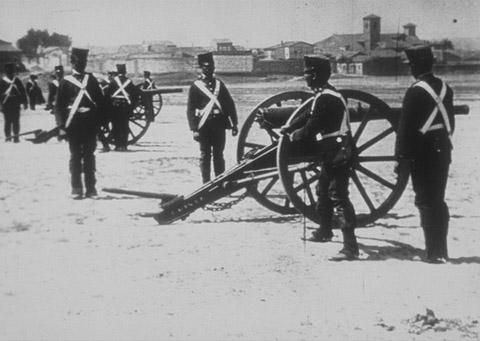
What about perforations? the reader may ask. While the Edison kinetoscope and the cinematographs of Lumière and Joly-Normandin all used 35mm film, the perforations were quite different. Edison used four rectangular sprocket holes on either side for each image, while the Lumières had only one round sprocket hole on each side. The Joly-Normandin image was almost as tall as it was wide, with each image taking up more space on the film strip, and with five sprocket holes on each side. At least some of the Joly-Normandin films, however, were also marketed in versions with Edison perforations (Blot-Wellens 2014: 42). Since Pacht was able to show Edison kinetoscope films, it is reasonable to conclude that his machine was designed for Edison-type sprocket holes. He would certainly have been able to run Méliès films on such a machine, and Lumière films as well, if he was able to get them unperforated. Early films were often sold without any perforations, allowing the individual exhibitior to punch out sprocket holes to fit his projector with a simple perforation device (Robert Paul made such devices in 1896; there are two in the Will Day collection at the Cinémathèque française (inventory no. AP-94-108)).
The Danish film historians we looked at at the beginning of this section who claimed that Pacht showed Lumière films made thus not have been as wrong as we might first have assumed when we saw that Pacht got his apparatus and most of the films for the June 1896 show from Robert Paul. They may only have been wrong about the timing: while Pacht definitely did not show Lumière films in the summer of 1896, he may have done so at the end of the year. None of this really explains, however, why Engberg and Krogh changed their minds, discarding the Lumière attribution instead of the Acres one.
How can we learn from mistakes?
Unfortunately, there are no records of Arne Krogh’s researches that I have been able to locate beyond Waldekranz’s mention, Engberg’s footnote, and a remark in Erik Nørgaard’s coffee-table book: “It has been widely assumed that Pacht’s first films came from Lumière, but that is false. Arne Krogh at the Danish Film Museum has investigated the matter and established that they were English” (Nørgaard 1971: 20). Nørgaard’s book appears to be the first publication to reject the Lumière attribution, as Deac Rossell points out (Rossell 2016: 406).
The Danish Film Museum (since 1996/97 part of the Danish Film Institute) maintained a very extensive collection of newspaper clippings, program booklets and archival notes on individual films, people, and institutions. A Pacht clippings file was the most likely place to find evidence of the researches conducted by Krogh, but there does not seem to be one. There is a file on the Panorama, but it only contains photocopies from the 1990s of the architectural drawings for the building (the originals are at the archives of the city of Copenhagen). On the file folder, we find a hand-written reference: “See also under PACHT, LAURITZ VILHELM.” However, repeated efforts to locate a clippings file on Pacht have been fruitless.
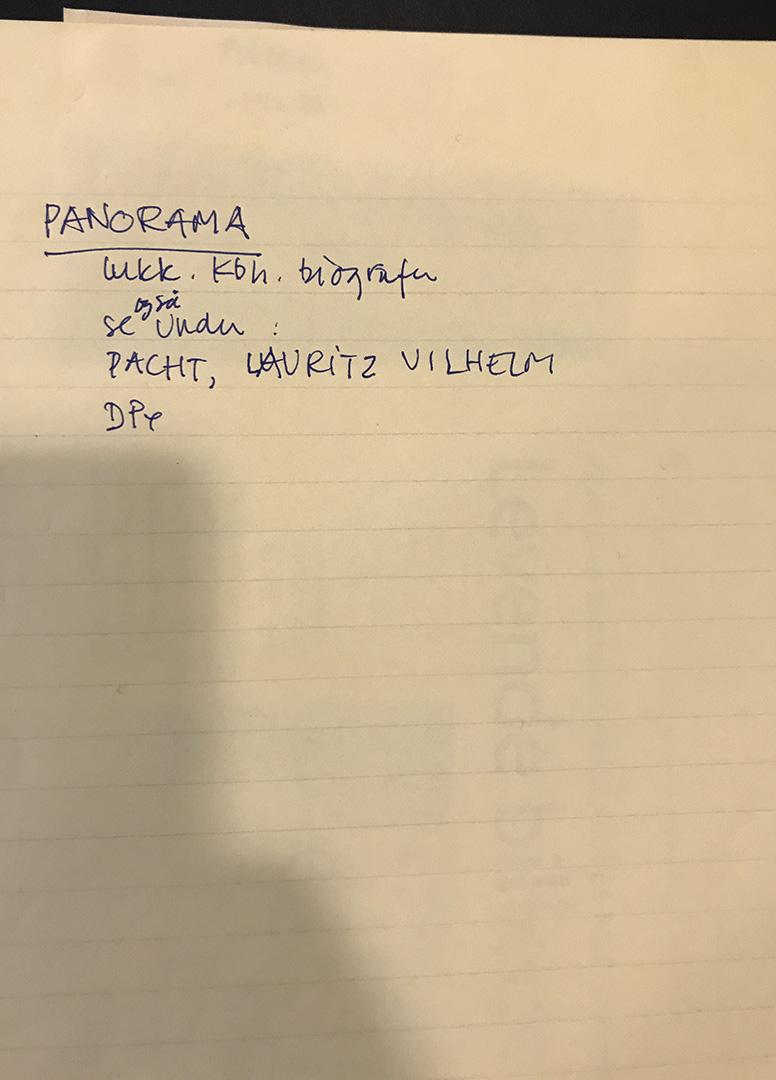
In Waldekranz’s 1955 account, there is no sign that Krogh had any doubts about the generally accepted Lumière attribution at that time. The doubts appear to have emerged later, possibly prompted by discussions with Kurt Petersen (1935-2011), an avid collector of film cameras, projectors and other cine-devices. Objektiv, the members’ magazine of the Danish Society for Photography History (a group of camera collectors and enthusiasts), devoted a special issue to Petersen’s collection. Here, TV professional and sometime film studies teacher Mogens Svane writes that Krogh did not have “univocal documentation for the veracity” of his “assessments,” and that “it was in fact Kurt Petersen who through his studies of the English film pioneers gradually convinced Arne Krogh that the first imported camera was of English origin” (Svane 1997: 53). Svane writes “camera” here, but in the context of going over the main points of Marguerite Engberg’s discussion of Pacht’s June 1896 film show and projection apparatus. The rest of the article is about cameras, however, creating a frustrating ambiguity.
Whatever the reasoning behind Krogh’s change of heart, it must have seemed satisfactory to Engberg. I do not have the sense that the first film shows preoccupied her all that much anyway – her main interest evidently lay with the feature films made after 1910. The fact that she re-used her 1958 article almost word for word in her 1977 book would suggest that she did not think there was any reason to back over what she considered well-trodden ground. However, even though her footnote made evident that the researches attributing Pacht’s apparatus to Acres were Krogh’s, not her own, she gave the attribution her imprimatur by repeating it. Other specialists have accepted it on the basis of her authority as the leading historian of Danish silent cinema.
When the first volume of Rune Waldekranz’ general history of film, Filmens Historia: de första hundra åren, appeared in 1985, he repeated the Acres attribution: “It was the projector and films of the English pioneer Birt Acres that Pacht had succeeded in acquiring during a visit to London” (Waldekranz 1985: 210-211). Filmens Historia does not have a full apparatus, but Waldekranz presumably relied on Engberg’s Dansk stumfilm: de store år, a work he would have know well, having suggested to Engberg that she submit it to the University of Stockholm, where he had been made the first professor of Film Studies in 1970, to earn the Swedish doctoral degree, which she duly did in 1978 (Schepelern 2003).
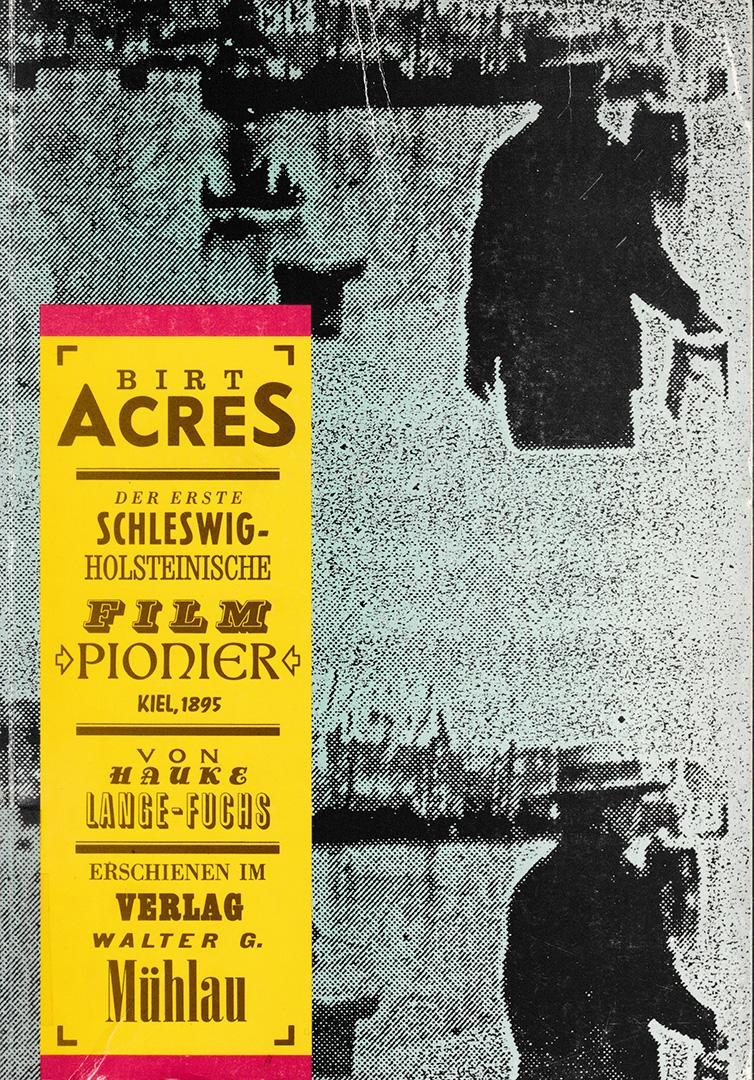
Another important scholar to accept Engberg’s authority was Hauke Lange-Fuchs (1934-2019). Lange-Fuchs was, besides his law practice, one of the leading promoters of Scandinavian film in Germany and a key figure behind the Nordische Filmtage festival in Lübeck. He did pioneering research on the films shot in Schleswig-Holstein by Birt Acres in 1895 (Lange-Fuchs 1987; 1995). Rossell cites both Lange-Fuchs and Waldekranz in a way that suggests they gave at least some independent authority to the Acres attribution:
The Swedish early cinema and silent film specialist Rune Waldenkranz [sic] came to the same conclusion […] Hauke Lange-Fuchs repeated the Acres attribution in his book Birt Acres (1987, 75–79), and quoted as well the work of Sigurd Evensmo from 1967 in Det store Tivoli that identified two of the films Pacht exhibited as Birt Acres films, The Derby and Rough Sea at Dover. (Rossell 2016: 407)
This is slightly misleading. Evensmo (1912-1978) made no such identification. He was a novelist, broadcaster, and prolific writer, whose pioneering survey of Norwegian film history was respected enough to be reissued in 1992, as Gunnar Iversen has noted (2011: 11), but Det store Tivoli is unsourced and not entirely reliable. Evensmo lists three film titles, ‘Sadlepladsen ved Derbyet’ [The Enclosure at the Derby], ‘Bølger mod den engelske kyst’ [Waves at the English Coast], and ‘Jernbanetog ankommer og afgår’ [Railway train arriving and departing], but describes them as “Lumière episodes” (Evensmo 1967: 18). Lange-Fuchs, much more conversant with Acres, then writes that Evensmo “mentions the unquestionably Acres-made films ‘Sadlepladsen ved Derbyet’ and ‘Bølger mod den engelske kyst’ (‘Rough Sea at Dover’)” (Lange-Fuchs 1987: 86 note 34). While Lange-Fuchs is correct in his identification, he artfully conceals that Evensmo did not refer to the wave film as Rough Sea at Dover and in fact believed it was a Lumière picture.
Now, picking apart brief remarks and footnotes in old film books in this manner may seem merely pedantic quibbling and fault-finding, but that is not my purpose. I do not wish to disparage the work of previous generations of film historians, often carried out as a spare-time activity under difficult circumstances with little institutional support. Moreover, academic discussions then and now sometimes degenerate into polemics; accusatory claims may produce responses that are more defensive than enlightening, because small errors are sometimes exploited to discredit broader arguments. Engberg’s most incautious remark about the source of Pacht’s films came, as we saw at the end of the first section, in her response to John Ernst’s comments about the “depressingly low state of Danish film history writing” (Ernst & Lund 1966: 158; see also Engberg & Ernst 1966: 208). When scholars worry that any mistakes they make will be thrown in their face along with charges of incompetence, a reluctance to admit error directly is the likely result. Mistakes get corrected, but without acknowledgement and, worse, without explanation for the change.
The same mechanism may also be at work when one scholar cites others in ways that elides their mistakes: part of the reason may be to strengthen one’s own argument by making the authorities on which one relies seem more reliable, but a reluctance to make an admired predecessor look bad may also play a part. When Lange-Fuchs makes it look like Evensmo and not he himself made the connection between “Waves at the English Coast” and Rough Sea at Dover, it may well have been intended as a gesture of respect towards the Norwegian writer’s pioneering work. I would argue that we could perhaps avoid some of these omissions and elisions and thereby make our work more transparent, if we strove to find a way of discussing errors that avoided polemics as far as possible. The biblical injunction about the mote in your brother’s eye and the beam in your own (Matt. 7: 3-5) is always worth pondering.
We film historians inevitably make mistakes, and these mistakes are sometimes passed on to others. We cannot research everything ourselves, and we are to a considerable degree forced to rely on the work of fellow researchers, and they will rely on our work in turn. One pitfall that the Acres attribution example illustrates is how caveats may be dropped when researchers repeat claims made by others. With her footnote crediting Krogh and his researches, Engberg also gave warning that this was not something she had personally confirmed; but subsequent researchers would state it as something already proven.
Similarly, when historical accounts are paraphrased, they sometimes get skewed in imperceptible ways – most often in favor of the argument of the researcher doing the paraphrasing or simply in favor of drama. In Rossell’s discussion of the fire that affected Pacht’s Panorama on the night of 18 June 1896, he writes that “the temporary structure burned to the ground in the night” (405). Rossell assumes that Pacht had to replace his projector and was able to do so within two weeks, when screenings resumed. This broadly agrees with Béranger’s previously-quoted account: “On 18 June, a fire erupted at Pacht’s ‘stand’ and ravaged his projector. […] Nevertheless, by 30 June, the damage had already been repaired, and the hall reopened its doors with a new projector sent from Paris in all haste” (Béranger 1960: 20). Béranger, as we have seen, relied on Waldekranz, who wrote (referring to Krogh as the source of his information) that “the apparatus and part of the building were destroyed by a fire” (Waldekranz 1955: 13). Here, the building is only partly destroyed. Engberg’s description is very similar: “The apparatus and part of the wooden building burned in a dramatic fire on 18 June, less than a fortnight after the opening” (Engberg 1958: 136; 1977: 14)
If Krogh and Engberg relied on Politiken (which seems most likely), it must be said that their paraphrases overdramatize a bit. Politiken’s report specifies that the fire had begun “in the adjacent-lying wooden shed wherein the machine employed by the Copenhagen Panorama to produce its moving lantern-pictures was installed. From there, the fire spread to the exhibition building itself.” The fire was quickly put out, and while the shed in the back burned, the exhibition building itself only suffered minor damage. The report continues: “The damage was quite negligible. The machine installed in the little wooden building was in fairly bad shape and must undergo careful repair before it can be used again” (Politiken, 18 June 1896).
Moreover, if we look at other newspaper accounts, it becomes clear that the “machine” described as damaged was in fact not the projector at all, but an electrical generator powering it: “The fire did not reach as far as the Kinoptikon itself with the apparatuses by which the living pictures are reproduced. However, the machines through which electricity was conducted to the Kinoptikon were completely destroyed” (København, 30 June 1896). Pacht could therefore reopen on 30 June with the same projector and largely the same films as on 7 June.
The fire is significant to Rossell’s argument. He urges us to reassess the scope of Acres’ activities on the basis of him not only supplying Pacht’s projector but being “able to replace the projector destroyed in Pacht’s fire within two weeks, which indicates either a readily available stock on hand or a capability to manufacture quickly that is elsewhere not recorded” (407). Unfortunately, he was misled by existing Danish accounts on both these points: Pacht’s projector was in all likelihood supplied by Robert Paul, and it survived the fire and did not require a replacement on short notice. Still, these matters of fact aside, I believe it is important to commend Rossell on the suggestiveness of his examples and the soundness of his advice.
Conclusion: Serendipity and the Second Record
In this article, I have tried to deepen our knowledge of the 1896 Kinoptikon film shows at Vilhelm Pacht’s Panorama, adding details and clarifications to existing accounts. In the course of doing so, I have also examined and traced these previous accounts’ mistakes and inaccuracies. Here, precisely because they are the most authoritative, the accounts of Engberg, Waldekranz, and Rossell have loomed large. I have not subjected them to this kind of scrutiny out of a desire to cast aspersions on their work, which I continue to hold in high regard, but in order to show that even careful researchers can be led astray, particularly when they have to rely on accounts by others who do not clearly identify the sources supporting their claims.
To round off, I want to bring up an important point I believe this article demonstrates: the truth of one of the corollaries of the first of the quartet of rules set out by Rossell. The early cinema historian, he writes, “must work across national borders and across languages” (Rossell 2016: 404). In order to really describe Pacht’s first and second film shows properly, I have had to consult publications in English, French, German, Italian, and Spanish, as well as the three Scandinavian languages. Because of the thorougly international character of early cinema, an entangled history approach is clearly the way to go. It derives from the histoire croisée approach described by Michael Werner and Bénédicte Zimmermann (2006). Malte Hagener (2014) and Daniël Biltereyst and Philippe Meers (2020) have briefly discussed entangled film history as a methodological approach, and I have applied it to Carl Th. Dreyer (1889-1968) in another article (Tybjerg 2021). The entangled history approach rejects methodological nationalism and stresses the importance of cross-border connections without making them into an exclusive concern. It also has a self-reflexive component, stressing how film historians themselves are enmeshed in a particular scholarly and institutional context.
The latter kind of entanglement meshes importantly together with the fourth of Rossell’s rules: “Useful information can come from anywhere, keep your eyes wide open” (2016: 414). The importance of serendipity has long been recognized by thoughtful commentators on scholarship and the historian’s craft (Compagnon 2014; Eco 1998; Goggin & Goggin 2018; McClellan 2005; Merton & Barber 2006). This entire article was in a way a happy accident – having to present a paper on Valdemar Koppel’s review of Pacht’s show, I began to wonder about exactly which film of an oncoming train Koppel had seen, and investigating that produced all kinds of interesting new discoveries and questions. The literature on serendipity emphasizes that fortune favors the prepared mind – that the fortuitous finding is not a matter of blind luck, but precisely of keeping one’s eyes open. It is also clear, however, that while all historians should have prepared minds, each historian’s mind is prepared in a different way. Serendipitous discovery will often happen for reasons that are unique to the individual historian making the connection.
Each historian brings a particular set of experiences, a particular array of background knowledge to bear on the topic at hand. The brilliant American historian J. H. Hexter (1910-1996) called the sum of the historian’s personal experience “the second record” and showed how it could be an important source of understanding and insight (Hexter 1971: 80-109; see also Tybjerg 2013). These ideas align with the way the entangled approach emphasizes the historian’s own entanglement with his or her object of study. This is different from the way constructivist theories of knowledge stress the inevitable subjectivity of the researcher, the way he or she must remain trapped by their own perspective and interests. The entanglement can be a source of strength, an ability to spot interconnections that would otherwise escape notice.
In my own case, I have for many years been a regular at the Giornate del cinema muto, the Pordenone Silent Film Festival (which also features in Rossell’s own example of the serendipitous discovery of information). Having witnessed the presentations of Joly-Normadin films in 2013 and the flipbook restorations in 2019 certainly made it easier for me to get a sense of Pacht’s December 1896 program. There were also books that I brought home from the festival that I had never imagined that I would find useful for understanding Danish film history, like Aldo Bernardini’s two filmographies of early actuality films from and made in Italy (2002; 2008; they have been put online, but I would probably not have known to look for them had I not had the volumes).
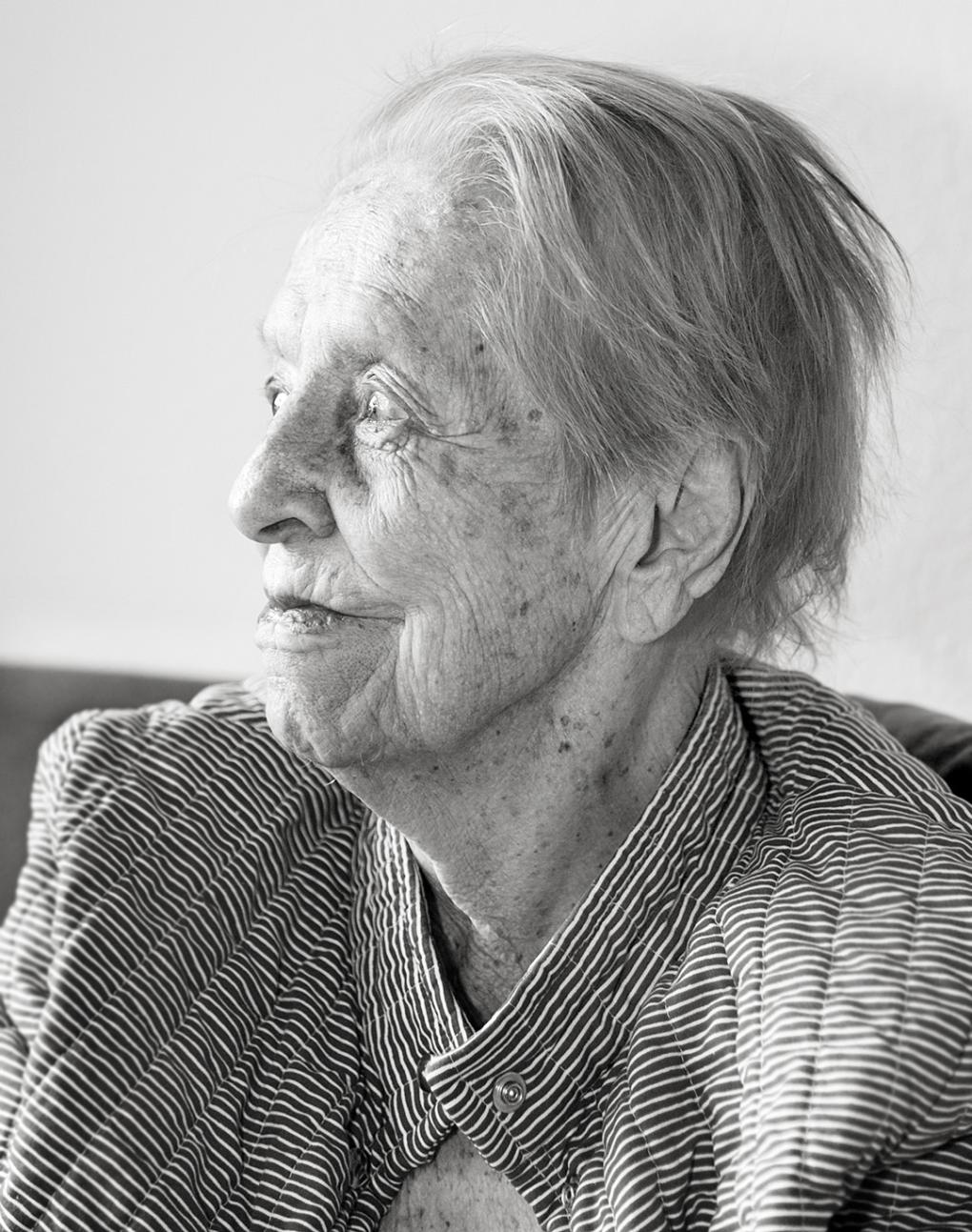
The significance of an institution like the Pordenone festival brings me to my final point: that as film historians, we are part of a community with its own history, a history with which we are inextricably entangled. It was from Marguerite Engberg that I first heard of the Pordenone festival; when I was a first-year student in 1986, she spoke enthusiastically about going there, and I remember thinking that it sounded kind of neat. And it was the last course she gave before retiring in the spring of 1989 that gave me the opportunity to see many of the films of Benjamin Christensen (1879-1959), who was the topic of the course. I was fascinated by Christensen’s films; when I embarked on my Ph.D., they were at the center of my project, and two of my first academic articles were about him. As scholars, we all have such entanglements with those who came before us. And while we may find things in their works with which we disagree, we should keep in mind that the way we state our disagreements reflect back on ourselves and affect the community of researchers as a whole.
Acknowledgements
In writing this article, I received a great deal of help from other researchers, and I wish to offer my thanks to Thomas Christensen, Ian Christie, Briony Dixon, Anders Marklund, Steen Kaargaard Nielsen, Peter Schepelern, Isak Thorsen, Per Vesterlund.
Sources of biographical dates
Blot-Wellens (2014): Ernest Normandin
danish-bottles.dk/filmhistorie.htm: Kurt Petersen
danskefilm.dk: Arne Krogh
danskforfatterleksikon.dk: Arnold Hending, J.J.Ipsen
dfi.dk: H. Andersen, Benjamin Christensen, Carl Th. Dreyer, John Ernst
IMDb.com: Jean Béranger
lex.dk: Ove Brusendorff, Valdemar Koppel, Erik Nørgaard, Vilhelm Pacht, Rune Waldekranz
snl.no: Sigurd Evensmo
victorian-cinema.net: Birt Acres, Henri Joly, Clement Maurice, Georges Méliès, Robert Paul
Wikipedia: J. H. Hexter, Charles H. Hoyt, Hauke Lange-Fuchs
Online resources
- Cinémathèque française apparatus collection catalogue: https://www.cinematheque.fr/fr/catalogues/appareils/
- Paul perforation device: https://www.cinematheque.fr/fr/catalogues/appareils/collection/perforatrice-de-film-35-mmap-94-108.html - Thomas A. Edison Papers: http://edison.rutgers.edu/
- Italian Silent Cinema Resources (including Bernardini’s filmographies): https://www.ilcinemamuto.it/
- Lumière catalogue: https://catalogue-lumiere.com/
- Artillerie (exercice du tir) (no. 267): https://catalogue-lumiere.com/artillerie-exercice-du-tir/
- Levée de filets de pêche (no. 58): https://catalogue-lumiere.com/levee-de-filets-de-peche/
- Port et Vésuve (no. 282, 1896): https://catalogue-lumiere.com/port-et-vesuve/ - Mediestream (Danish Digital Newspaper Archive): https://www2.statsbiblioteket.dk/mediestream/
- San Francisco Silent Film Festival (Flip Books): https://silentfilm.org/preservation/flipbooks/
Works Cited
Andersen, H[ans Peter Henrik] (1924). Filmen i social og økonomisk Belysning. Copenhagen, Komiteen til Belysning af Statsmonopoler.
Aubert, Michelle and Jean-Claude Seguin (1996). La production cinématographique des Frères Lumière. Paris, BiFi/Bibliothèque du Film.
Barnes, John (1998). The Beginnings of the Cinema in England, 1894-1901, vol. 1: 1894-1896. Exeter, University of Exeter Press.
Béranger, Jean (1960). La grande aventure du cinéma suédois. Paris, Éric Losfeld, Le Terrain vague.
Bernardini, Aldo (2002). Cinema muto italiano: i film" dal vero": 1895-1914. Gemona, La cineteca del Friuli.
Bernardini, Aldo (2008). Cinema delle origini in Italia: i film dal vero di produzione estera: 1895-1907. Gemona, La cineteca del Friuli.
Biltereyst, Daniël and Philippe Meers (2020). “Comparative, Entangled, Parallel and ‘other’ Cinema Histories. Another Reflection on the Comparative Mode Within New Cinema History.” In: TMG Journal for Media History 23 (1-2): 1-9.
Blot-Wellens, Camille (2014). El cinematógrafo Joly-Normandin (1896–1897): Dos colecciones: João Anacleto Rodrigues y Antonino Sagarmínaga. Madrid, Filmoteca española.
Brown, Richard and Barry Anthony (2017). The Kinetoscope: A British History. East Barnet, John Libbey.
Brusendorff, Ove ([1939-41]). Filmen: Dens Navne og Historie. Copenhagen, Universal-Forlaget.
Christie, Ian (2019). Robert Paul and the Origins of British Cinema. Chicago, University of Chicago Press.
Compagnon, Antoine (2014). “The Resistance to Interpretation.” New Literary History 45 (2): 271-280.
danskefilm.dk.
Eco, Umberto (1998). Serendipities: Language & Lunacy. New York, Columbia University Press.
Engberg, Marguerite (1958). “De første danske filmforevisninger.” In: Kosmorama no. 33, February: 136-139.
Engberg, Marguerite (1964). Dansk filmlitteratur: en bibliografi. Copenhagen, Det danske filmmuseum.
Engberg, Marguerite (1977). Dansk stumfilm: De store år. Copenhagen, Rhodos.
Engberg, Marguerite and John Ernst (1966). “Læserbreve.” In: Kosmorama no. 75, July: 208.
Ernst, John (1967). “Pacht i Paris.” In: Kosmorama no. 81, October: 13.
Ernst, John and Jørgen-Richard Lund (1966). “Apropos Løvejagten.” In: Kosmorama no. 74, May: 158-159.
Evensmo, Sigurd (1967). Det store tivoli: Film og kino i Norge gjennom 70 år. Oslo, Gyldendal Norsk Forlag.
Goggin, Peter N. and Maureen Daly Goggin, eds. (2018). Serendipity in Rhetoric, Writing, and Literacy Research. Logan, Utah State University Press.
Hagener, Malte (2014). “Introduction: The Emergence of Film Culture.” In: Malte Hagener (ed.), The Emergence of Film Culture: Knowledge Production, Institution Building, and the Fate of the Avant-Garde in Europe, 1919-1945, 1-18. New York, Berghahn Books.
Hending, Arnold (1945). Da Isbjørnen var lille. Copenhagen, Urania.
Hexter, J. H. (1971). The History Primer. New York, Basic Books.
Ipsen, J. J. (1926). En Utopists Historie: Erindringer. Copenhagen, Woel.
Iversen, Gunnar (2011). Norsk filmhistorie: spillefilmen 1911-2011. Oslo, Universitetsforlaget.
Lange-Fuchs, Hauke (1987). Birt Acres, der erste Schleswig-Holsteinische Filmpionier. Kiel, Verlag Walter G. Mühlau.
Lange-Fuchs, Hauke (1995). Der Kaiser, der Kanal und die Kinematographie: Begleitheft zur Ausstellung im Landesarchiv Schleswig-Holstein: Birt Acres - 100 Jahre Film in Schleswig-Holstein. Schleswig, Landesarchiv Schleswig-Holstein.
Lecointe, Thierry , Pascal Fouché, Robert Byrne and Pamela Hutchinson (2020). Discovering Lost Films of Georges Mélies in fin-de-siecle Flip Books (1896-1901) / Des fragments de films Mélies disparus ressuscités par des flip books (1896-1901). New Barnet, John Libbey.
Loiperdinger, Martin (1999). Film und Schokolade: Stollwercks Geschäfte mit lebenden Bildern. Frankfurt a.M., Stroemfeld/Roter Stern.
Malthête, Jacques and Laurent Mannoni (2008). L’Œuvre de Georges Méliès. Paris, Cinématheque française/Editions de la Martinière.
McClellan, James E., III (2005). “Accident, Luck, and Serendipity in Historical Research.” In: Proceedings of the American Philosophical Society 149 (1): 1-21.
Merton, Robert K. and Elinor Barber (2006). The Travels and Adventures of Serendipity: A Study in Sociological Semantics and the Sociology of Science. Princeton, Princeton University Press.
Musser, Charles (1997). Edison Motion Pictures, 1890-1900: An Annotated Filmography. Washington, D.C., Smithsonian Institution Press.
Nielsen, Steen Kaargaard and Claus Byrith (2017). Danmarks første lydoptagelser: Edisons fonograf i 1890’ernes København. Aarhus, Aarhus Universitetsforlag.
Nørgaard, Erik (1971). Levende billeder i Danmark: Fra ‘Den gamle Biograf’ til moderne tider. [Copenhagen], Lademann.
Rittaud-Hutinet, Jacques and Chantal Rittaud-Hutinet (1999). Dictionnaire des cinématographes en France (1896-1897). Paris, Honoré Champion.
Rossell, Deac (2016). “Quartet: Four Stories of Early Cinema Research.” In: Early Popular Visual Culture 14 (4): 403-419.
Sadoul, Georges (1948). Histoire générale du cinéma, vol. 1: L'invention du cinéma, 1832-1897. Paris, Denoël.
Schepelern, Peter. (2003). “Marguerite Engberg.” Dansk kvindebiografisk leksikon Retrieved 22 December, 2020, from https://www.kvinfo.dk/side/597/bio/804/origin/170/.
Seguin, Jean-Claude (1997). “Le cinématographe Lumière. Les retombées financières sur la Société des plaques et papiers photographiques (1895-1898).” In: 1895, revue d'histoire du cinéma: 3-15.
Svane, Mogens (1997). “Var Pacht før Elfelt?” In: Objektiv no. 77: 53-54.
Tybjerg, Casper (2013). “‘The Sown and the Waste’; or, the Psychedelic Writing of Film History.” In: NECSUS: European Journal of Media Studies 2 (2): 509-525.
Tybjerg, Casper (2021). “The European Principle: Art and Border Crossings in Carl Theodor Dreyer’s Career.” In: Isak Thorsen, C. Claire Thomson and Pei-Sze Chow (ed.), A History of Danish Cinema, 41-50. Edinburgh, Edinburgh University Press.
Tybjerg, Casper (2022). “Lost Love on a Hot Summer Day: The Absorptive Experience of the First Film Show in Denmark.” In: Mario Slugan and Daniel Biltereyst (ed.), New Perspectives on Early Cinema History: Concepts, Approaches, Audiences, 83-100. London, Bloomsbury Academic.
Waldekranz, Rune (1955). Levande bilder: de första biograferna. Stockholm, Sveriges biografägareförbund.
Waldekranz, Rune (1985). Filmens Historia: De första hundra åren: från zoopraxiscope til video, vol. 1: Pionjärtiden 1880-1920. Stockholm, Norstedts.
Werner, Michael and Bénédicte Zimmermann (2006). “Beyond Comparison: Histoire Croisée and the Challenge of Reflexivity.” In: History and Theory 45 (1): 30-50.
Suggested citation
Tybjerg, Casper (2022), The First Danish Film Shows Revisited: A Historiographical Study. Kosmorama #281 (www.kosmorama.org).
